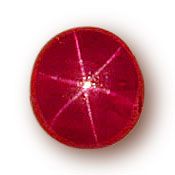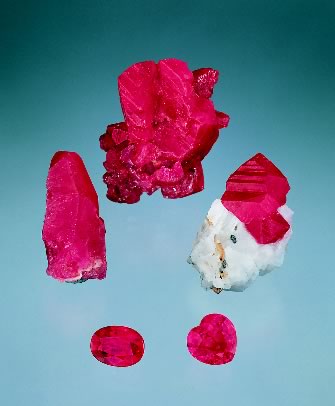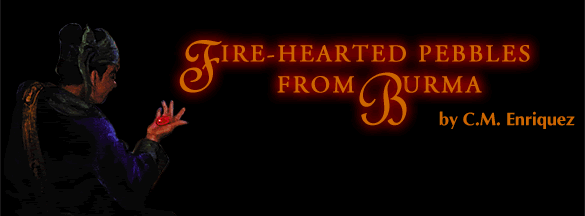
Fire-Hearted Pebbles from
Burma by C.M. Enriquez
Reprinted
from Asia magazine, October, 1930, Vol. 30, No. 10,
pp. 722–725, 733
Old as the hills are the blood-red rubies that sparkle on the fingers of beautiful women and in the turbans of Indian maharajas. Old as the hills – and, as I look out upon the tortured granite peaks of Mogok, I endeavor to appreciate the stupendousness of that antiquity. The earth was young when these molten rocks were thrust in amongst the limestone that once covered all Burma and the Indo-Chinese peninsula.
To reach the Mogok ruby mines you must travel for a day
from Mandalay up the Irrawaddy by steamer and thence for sixty miles by motor
along a road that leads through gorgeous forests toward the heart of the mountains.
The scenery is exquisite. Indeed, there is none finer in Burma, and Mogok is
on the tourist route – or should be. At last, at four thousand feet, you
come to the “Winding Valley” – for such is the meaning of the
Shan name, Mong Kut, of which Mogok is the Burmese corruption.
Picture
in the bottom of the valley two lakes – both of
them abandoned and flooded ruby mines – around
which clusters the little town of eight thousand inhabitants.
In the market place are found all sorts of strange
folk – Kachins, Lisus and Shans from the adjacent
mountains and Chinese, Shan-Tayoks and Maingthas from
across the Chinese border. Every fifth day they crowd
into Mogok to buy and to sell; for markets are still
held here as in the days of Marco Polo. It is a gay
scene, where women battle furiously for mushrooms or
orchids or rice, a whole array of mysterious and repellent-looking
jungle produce reputed, in spite of its appearance,
to be good to eat, cook or chew.
Picture
in the bottom of the valley two lakes – both of them
abandoned and flooded ruby mines – around which clusters
the little town of eight thousand inhabitants. In the market
place are found all sorts of strange folk – Kachins,
Lisus and Shans from the adjacent mountains and Chinese,
Shan-Tayoks and Maingthas from across the Chinese border.
Every fifth day they crowd into Mogok to buy and to sell;
for markets are still held here as in the days of Marco
Polo. It is a gay scene, where women battle furiously for
mushrooms or orchids or rice, a whole array of mysterious
and repellent-looking jungle produce reputed, in spite
of its appearance, to be good to eat, cook or chew.
“Old as the hills are the blood-red
rubies that sparkle on the fingers of beautiful women and
in the turbans of Indian maharajas.”
Altogether
more decorous are the crowds that collect on other
occasions to buy and sell stones. These are mostly
composed of men skilled in the art of valuing gems
or in showing them to the best advantage. There are
some jewels which may be viewed only in the sunset.
Others are bid for mysteriously, sellers and buyers
seating themselves at a table with the stones between
them and holding hands under the table. By squeezing
finger joints – which denote tens, hundreds or
thousands of rupees they arrive at a price secretly;
for a beautiful ruby, like a beautiful woman, depreciates
in value (here at least) by being publicly discussed.
Round
about rise the marvelous mountains,
placid in the sunshine, veiled with
mist in the rains, painted with azaleas
and bauhinias in the spring and with
cherry-blossoms at Christmas, when
the petals rain down upon the ground
like a gracious carpet. In winter there
is cold, scintillating sunshine, with
blue-black shadows in the forest. The
monsoons bring a rainfall of nine feet – but
there are frequent breaks. Because
of its elevation Mogok is always cool,
and the climate is pleasant and healthful.
It is as if the gods had favored the
Winding Valley with their beautiful
jewels – red ruby and blue sapphire – and
their loveliest blossoms – from
temperate peach to tropical orchid – and
as if man, for once in his life, had
decided to leave Nature alone. Tucked
away far from the outer world, isolated
amidst its sheltered mountains, Mogok
possesses that now rare quality of
being absolutely unspoiled.
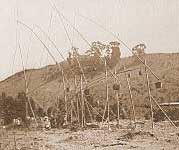 |
Burma
is the home of the rubies and sapphires.
The mines of Ceylon, Siam and Indo-China
produce stones equal in color but not, as
a rule, equal in size to those of Burma.
The Burmese gem mines are shallow pits worked
with little or no machinery by all sorts
of strange folk. From gravel beneath the
clay surface, clear red and blue crystals
of corundum – named rubies and sapphires – eventually
find their way to Paris or into rajas’ treasuries.
Anybody is free to wash the rubbish discarded
by the licensed miners for small stones,
suitable for watch jewels. The upper left-hand
picture shows a Chinese ruby mine, in which
the earth is raised by bamboo lifts; each
hole is one mine. |
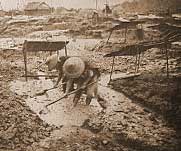 |
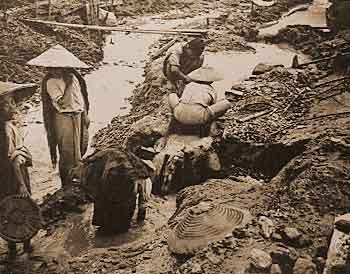 |
|
Upon
it frown the surrounding peaks. The granite pinnacles
add just the correct touch of savagery to the placid
and lovely landscape. Of the limestone little is left.
The rains of uncounted ages have washed it away; subterranean
fires have changed it till no vestige remains of its
former structure. There is hardly a fossil left whereby
to date these ancient rocks. The only ones ever found
are certain Brachiopoda – terebratulae
washed out of their original site and rolled down into
the valleys along with masses of gravel, sand and rubbish,
among which occur the rubies and sapphires. Rubies
are found high up on the mountains, too, but they are
mostly worked in the new alluvial beds of the valley
bottoms where they have drifted into the chinks and
crevices of the ancient rock.
The
Burma Ruby Mines Company has worked
these deposits for the past forty years,
but now its lease is drawing to an
end. There are, besides, innumerable
native mines – some licensed and
independent, others working under the
company. But in all cases the method
of work is much the same. The surface
of reddish lateritic clay is removed
to lay bare the lower gravels, which
are the ruby-bearing strata. The appearance
of a mine is usually that of a shallow
pit, either small or large. Here and
there shafts and tunnels are dug in
special circumstances, but as a rule
the mines are open. In all these gem-bearing
localities there has been the same
violent intrusion of granite, the same
metamorphosis of what is presumed to
have been limestone. In all are found
these fire-hearted pebbles for which
women yearn and for which men fight
and toil.
“In all these gem-bearing
localities there has been the same violent intrusion of
granite, the same metamorphosis of what is presumed to
have been limestone. In all are found these fire-hearted
pebbles for which women yearn and for which men fight and
toil.”
Burma
is essentially the home of rubies. The mines of Ceylon,
Siam and French Indo-China are worthy rivals, producing
stones equal in color but not as a rule equal in size
to those of Burma. Rubies! How they tempt, charm, fascinate;
their red flame suggests earth's primeval conflagration.
Shrouded in their coat of rust, they ask the momentous
question: “Am I rendered valueless by flaws or
reduced by ‘satin’ stains to the rank of
a star ruby, which only Americans seem to appreciate,
or am I a flawless, blood-red gem worth a king's ransom?” The
sapphires ask the same exasperating question. And since
early times men have thought it worth while to risk
searching for the answer.
These
mines of Mogok in Burma were probably
discovered by the Chinese, who first
located the lead and silver of Bawdwin
and the tin deposits of Perak and Kinta.
Certain bronze spearheads of marked
uniformity found in the Mogok gravel
among prehistoric stone implements
suggest that possibly troops or police
may once have guarded the mines. In
Burmese times the mines were worked,
as now, by Burmese and cognate races – Shans,
Shan-Burmese and Maingthas – and
were the monopoly of the Burmese kings
of Ava, Amarapura and Mandalay. The
king claimed all stones over a certain
weight and quality, but, human nature
being then what it still is, many fine
rubies were cut up to defraud him of
his dues. To this day several local
village names record what the kings
thought when they discovered their
losses and what retribution they inflicted.
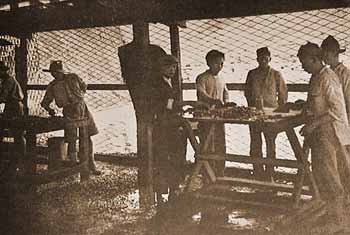 |
| At
Mogok, in Upper Burma, center of the ruby-mine
district, practically every one owns shares
in some sort of mine. The richest gravels
are collected for scrutiny on tables in the
sorting sheds, where guards keep close watch
over the workers to prevent them from smuggling
any gems out of the area. Spontaneous enmities
among the workers are also an insurance against
theft. |
|
The
finest ruby known to have been found at Mogok in
medieval times was the Ngamauk, which was in the
possession of Mindon Min, the last king of Burma
but one. He was excessively proud of it and showed
it to some of the foreign ambassadors who from time
to time visited his court. He valued the gem as being
worth half his kingdom. The Ngamauk Ruby descended
to Mindon’s ill-fated son, Thibaw, with whom
it remained until that day when the British army
took him prisoner in the summer-house of his palace
at Mandalay. From that day to this the famous jewel
has never been seen again. At one time or another
nearly everybody connected with the events at Mandalay
was accused of stealing the Ngamauk, and there are
a thousand ways in which it may have disappeared.
Perhaps the palace folk took it when they deserted
with cartloads of treasure. Perhaps some lucky soldier
or sepoy got it – though that is highly improbable.
Perhaps
it was given to some minister to keep
or the King himself may have retrieved
this so portable “half of the
kingdom.” Certainly he denied
possession of it and later threatened
to prosecute the British government.
“The Ngamauk Ruby descended
to Mindon’s ill-fated son, Thibaw, with whom it
remained until that day when the British army took him
prisoner in the summer-house of his palace at Mandalay.
From that day to this the famous jewel has never been
seen again.”
The
finest stone dug up in recent times is the forty-three-carat “Peace
Ruby” – reduced as cut to twenty-four carats – discovered
on Armistice Day and later for sale in Paris for
thirty thousand pounds, I believe. Stones so huge
are difficult to dispose of in these days when crowns
and regalia are a drug on the market. Paris consumes
most of the Burma rubies. It would surprise most
persons to see the apparently poor Burmese with agents
of their own in the rue de la Paix and the wretched
cottages here in Mogok in which priceless jewels
are kept in a cigarette tin.
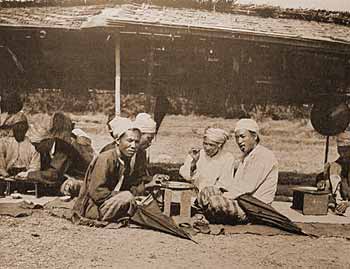 |
| Men
skilled in valuing gems assemble at Mogok.
Certain jewels are bid for mysteriously,
sellers and buyers seating themselves with
the stones between them and holding hands
under the table. By a code-squeezing of fingers,
they arrive at a price secretly; for it is
thought that a beautiful ruby, like a beautiful
woman, depreciates in value by being publicly
discussed. |
|
Life
in Mogok is a lottery in which the poorest has a chance,
and, if he happens to have nimble fingers and toes and
a disarming smile, he has a good chance. Any one may find
or steal a fortune any day. A small mine, which can be
worked for about one hundred and fifty rupees a month,
is usually financed by a little group. At the end of the
month some drop out and others take their places. Practically
every one in Mogok owns shares of this kind and lives on
in hope – mostly in hope – of a windfall to come.
You have to trust your partners, and this trust is a far
greater strain than might be imagined. The only practical
way of running a business on these lines is to give the
actual workmen a handsome share in the profits and then
to pick those who are deadly enemies, so that each will
watch the others like a cat. The recruiting of deadly enemies
should not be difficult in any Shan community, but the
worst of it is that they fall out of hate as easily as
they fall out of love.
Even
when loot combines them in an unholy friendship,
however, they usually fall out over the
spoils – but for which happy fact
no one in Burma would ever get any rubies
at all.
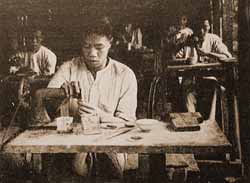 |
| Some
stone-cutters of the Burma gem mines
carry on their delicate work with equipment
consisting of an old sewing machine or
part of a dismantled bicycle. |
|
|
Palagems.com
Ruby Buying Guide
By Richard
W. Hughes
Introduction. The
term ruby is reserved for corundums of a red
color, with other colors called sapphire. In
Asia, pink corundums are also considered rubies.
Outside of Asia, such gems are generally termed
pink sapphires.
Color. For
ruby, the intensity of the red color is the primary
factor in determining value. The ideal stone
displays an intense, rich crimson without being
too light or too dark. Stones which are too dark
and garnety in appearance, or too light in color,
are less highly valued. The finest rubies display
a color similar to that of a red traffic light.
Lighting. Rubies
generally look best viewed with incandescent
light or daylight (particularly around midday).
Avoid fluorescent tubes, which have virtually
no output in the red end of the spectrum, and
so cause ruby to appear grayish.
Clarity. In
terms of clarity, ruby tends to be less clean
than sapphire. Buyers should look for stones
which are eye-clean, i.e., with no inclusions
visible to the unaided eye. In the case of some
rubies, extremely fine silk throughout the stone
can actually enhance the value. Many rubies also
display a strong red fluorescence to daylight,
and this adds measurably to the beauty of this gem.
 While
a certain amount of
silk is necessary to
create the star effect
in star ruby, too much
silk desaturates the
color, making it appear
grayish. This is not
desirable. While
a certain amount of
silk is necessary to
create the star effect
in star ruby, too much
silk desaturates the
color, making it appear
grayish. This is not
desirable.
Cut. In
the market, rubies are found in a variety of
shapes and cutting styles. Ovals are cushions
are the most common, but rounds are also seen,
as are other shapes, such as the heart or emerald
cut. Slight premiums are paid for round stones,
while slight discounts apply for pears and marquises.
Stones that are overly deep or shallow should
generally be avoided.
 Cabochon-cut
rubies are also common.
This cut is used for
star stones, or those
not clean enough to
facet. The best cabochons
are reasonably transparent,
with nice smooth domes
and good symmetry. Avoid
stones with too much
excess weight below
the girdle, unless they
are priced accordingly. Cabochon-cut
rubies are also common.
This cut is used for
star stones, or those
not clean enough to
facet. The best cabochons
are reasonably transparent,
with nice smooth domes
and good symmetry. Avoid
stones with too much
excess weight below
the girdle, unless they
are priced accordingly.
Prices.
With the exception of imperial jadeite and
certain rare colors of diamond, ruby is
the world‘s most expensive gem. But
like all gem materials, low-quality (i.e.,
non-gem quality) pieces may be available
for a few dollars per carat. Such stones
are generally not clean enough to facet.
The highest price per carat ever paid for
a ruby was set on February 15, 2006, when Laurence Graff, a London jeweler, paid a record $425,000 per carat ($3.6 million) for an 8.62-ct. ruby, set in a Bulgari ring, at a Christie’s auction in St. Moritz.
 Less than a year before, on April 12, 2005, an
8.01-ct. faceted stone sold for $274,656
per carat ($2.2 million) at Christie’s
New York. Previously the record for per-carat
price was held by Alan Caplan’s Ruby
(‘Mogok Ruby’), a 15.97-ct. faceted
stone that sold (also to Graff) at Sotheby’s New York,
Oct., 1988 for $3,630,000 ($227,301/ct). Less than a year before, on April 12, 2005, an
8.01-ct. faceted stone sold for $274,656
per carat ($2.2 million) at Christie’s
New York. Previously the record for per-carat
price was held by Alan Caplan’s Ruby
(‘Mogok Ruby’), a 15.97-ct. faceted
stone that sold (also to Graff) at Sotheby’s New York,
Oct., 1988 for $3,630,000 ($227,301/ct).
Stone Sizes. Large
rubies of quality are far more rare than large
sapphires of equal quality. Indeed, any untreated
ruby of quality above two carats is a rare stone;
untreated rubies of fine quality above five carats
are world-class pieces.
Phenomena. Ruby
may display asterism, the star effect. Fine star
rubies display sharp six-rayed stars well-centered
in the middle of the cabochon. All legs of the
star should be intact and smooth. Just having
a good star does not make a stone valuable. The
best pieces have sharp stars against an intense
crimson body color. Lesser stones may have sharp
stars, but the body color is too light or grayish.
On occasion, 12-rayed star sapphires are found.
Inexpensive star rubies come mainly from India.
|
|
This
4.86-ct. star ruby from Pala International
is one of the finest examples to come out
of Mogok in years.
(Photo: John McLean;
Gem: Pala
International) |
Name. The
name “ruby” is believed to be derived
from the Latin ruber, a word for red. According
to Oriental beliefs, ruby is the gem of the sun.
It is also the birthstone of July.
Sources. The
original locality for ruby was most likely
Sri Lanka (Ceylon), but the classic source
is the Mogok Stone Tract in upper Burma. Fine
stones have also been found in Vietnam, along
the Thai/Cambodian border, in Kenya, Tanzania,
Afghanistan, Pakistan, Yunnan (China) and most
recently, Madagascar. Low-quality rubies also
come from India and North Carolina (USA).
Enhancements. Today,
the vast majority of rubies are heat-treated
to improve their appearance. The resulting
stones are completely stable in color. Many
rubies are also heated in the presence of a
flux to heal their fractures, particularly
those from Möng Hsu, Burma. In lower qualities
and smaller sizes, heat treated stones sell
for roughly the same as untreated stones of
the same quality. However, for finer qualities,
untreated stones fetch a premium that is sometimes
50% or more when compared with treated stones
of similar quality. Other treatments, such
as oiling, dying and surface diffusion are
seen on occasion. As with all precious stones,
it is a good practice to have major purchases
tested by a reputable gem lab, such as the GIA or AGTA,
to determine if a gem is enhanced.
Imitations. Synthetic
rubies have been produced by the Verneuil process
since the 1890’s and cost just pennies
per carat. Ruby has also been produced by the
flux, hydrothermal, floating zone and Czochralski
processes. Doublets consisting of natural sapphire
crowns and synthetic ruby pavilions are fairly
common, particularly in mining areas. Synthetics
are also common at the mines, in both rough
and cut forms.
|
|
Fine
ruby specimens. The crystals are from, from
left to right, Afghanistan, Vietnam and Tanzania,
while the two faceted gems are from Mogok,
Burma.
(Photo: Harold & Erica Van Pelt; Gems: Pala
International). |
Properties of Ruby
| |
Ruby (a variety
of corundum) |
| Composition |
Al2O3 |
| Hardness (Mohs) |
9 |
| Specific Gravity |
4.00 |
| Refractive Index |
1.762–1.770
(0.008) Uniaxial negative |
| Crystal System |
Hexagonal (trigonal) |
| Colors |
Various shades of red.
Ruby is colored by the same Cr+3 ion that
gives alexandrite and emerald their rich hues. |
| Pleochroism |
Strongly dichroic:
purplish red/orangy red |
| Phenomena |
6 or 12-rayed
star |
| Handling |
No special care
needed |
| Enhancements |
Frequently heated;
frequently flux-healed; occasionally oiling,
dying, surface diffusion |
| Synthetic
available? |
Yes |
For further information on
ruby, see also:
For further information on
Burma, see also:
|
|

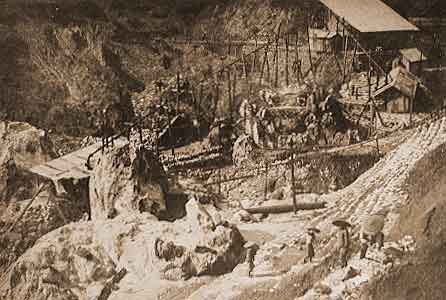






 While
a certain amount of
silk is necessary to
create the star effect
in star ruby, too much
silk desaturates the
color, making it appear
grayish. This is not
desirable.
While
a certain amount of
silk is necessary to
create the star effect
in star ruby, too much
silk desaturates the
color, making it appear
grayish. This is not
desirable.